How Does Real-Time Data Support Sustainable Mobility
Sustainability has been a hot topic over recent years, and for good reason. To protect our ecosystem and its inhabitants, we as a global community have to come together to make a change. One of the most significant contributors to our negative impact on the environment is vehicle emissions - and as most of the world utilizes some kind of transportation - this impact is huge.
In fact, transportation accounts for 29% of global green house emissions, the largest percentage of any sector. 58% of these emissions come from light-duty vehicles, the ones owned and driven by the majority of the world.
Fortunately, developments in technology, and particularly transportation technology, can help us minimize this impact while increasing mobility in cities. While achieving both of these goals simultaneously may seem impossible, it is made possible by technologies such as smart traffic control and traffic data analytics. Real-time data especially can transform modern transportation and help cities to achieve sustainable mobility.
What is Sustainable Mobility?
Often when we think of sustainability, it’s all about saving the environment. While this is true in some sense, sustainable mobility takes it one step deeper. Sustainable mobility refers to the overarching subject of transport mobility that is sustainable concerning environmental, climate, and social impacts.
As mentioned, transportation contributes heavily to our negative impact on the environment, but humans rely on vehicle transportation to hold up societies and economies. Whether commuting to work, to school, or the grocery store, transportation is a necessary component of the function of our global communities.
.webp?width=759&height=505&name=people-driving-cars-city-street-jpg%20(1).webp)
Still, a change needs to be made in order to preserve our environment without compromising on mobility within cities. This is where sustainable mobility comes in. This concept calls for the creation of solutions that ensure the flow of people, goods, and services, all the while mitigating climate change.
Sustainable mobility is primarily measured by transportation system effectiveness and efficiency, in addition to the environmental and climate impacts of the system. This means that for mobility in cities to be sustainable, it needs to be optimized. As such, cities need to manage traffic conditions, including congestion, accidents, traffic lights, and shared transportation such as ride-sharing vehicles or public transport.
Suppose cities can prevent congestion and reduce the number of vehicles on the road. In that case, they can optimize movement throughout their city and significantly reduce their environmental impact. So how can this be achieved?
Sustainable Mobility with Real-Time Data Support
One of the best ways to cultivate sustainable mobility within a city is through the use of real-time data support. In fact, city planners can then drastically improve the efficiency of movement within their areas.
Real-time data provides planners with knowledge of where congestion frequently occurs, where the majority of the population commutes to and from, and even which traffic lights are creating backups. As a result, city planners can make the changes necessary to improve movement, ensuring that citizens get from A to B as efficiently as possible.
As traffic congestion is a significant contributor to carbon emissions in cities, its reduction is essential. Urban planners can use real-time data to determine where congestion occurs and reroute drivers accordingly. Even in the long run, this data can be used to help planners make infrastructure improvements to avoid congestion in the future, such as adding extra lanes or changing traffic light patterns. With reduced congestion, drivers will not only save time but reduce their emissions.

In addition to congestion, another contributor to the environmental impact of transportation is the number of cars on the road. While public transportation and ride-sharing services are highly beneficial in reducing this, often, these vehicles are left vacant. As a result, the empty vehicles do laps around the city for essentially no purpose, defeating the purpose. Fortunately, real-time data can also be used to optimize the routes of public transport such as ride-sharing vehicles, buses, and subways.
With real-time data, these vehicles can receive timely updates on where passengers are, helping them to create optimal routes. As such, the vehicles can pick up passengers in high-volume locations and use the most optimal routes to drop them off at their designated locations. With this real-time data support, the vehicles designed to consolidate passengers efficiently can do so while manoeuvring the city with ease and reducing passenger-less trips.
As a result of real-time data support, sustainable mobility is possible. Citizens and drivers can move throughout cities more efficiently, increasing productivity and safety in their cities, all the while reducing their environmental impact. That being said, how do city planners obtain the real-time data support needed to cultivate this efficiency? The answer is simple: real-time traffic video analytics.
Obtaining Real-Time Data Support
There is no question that real-time data is the missing key to sustainable mobility. Most cities understand this, but they've lacked the proper technology to gather the real-time data necessary - until now.
With permanent traffic monitoring and counting of vehicles, bicycles and pedestrians in real-time, city planners can easily gather the up-to-the-minute insights needed to optimize their cities. Using sensors and cameras throughout an urban area, city planners can determine where congestion occurs, which areas have the most vehicle and foot traffic, and where public transportation needs to be extended to.
To take it one step further, real-time traffic data collection software uses road logistics algorithms to make on-the-fly micro-optimizations through actions such as syncing traffic lights, changing speed limits, and giving drives the most up-to-date alerts on highway alert signs. It also allows real-time route optimization and better parking.
GoodVision Live Traffic is the ideal solution for building up a next-generation traffic control system. The edge devices running Live Traffic software can be deployed on-site near the camera, processing the camera stream on the fly.
While having the right technology is definitely one issue, fostering cooperation between governments and private sectors and technology knowledge sharing is vital to achieving truly sustainable mobility.
As GoodVision Video Insights software is highly interoperable, it makes knowledge sharing between technologies not only feasible - but easy. City planners can share historical and real-time data as needed, spreading the wealth of knowledge and facilitating widespread optimization and sustainability.

Sustainable Mobility is the Future
As a society, it is absolutely vital that we make the collective decision to become more sustainable. That being said, the productivity and success of our global economies are highly dependent on the transportation of people, goods, and services. Modern problems require modern solutions, and in this case, real-time traffic data collection software is the answer.
As travel is more efficient and safe, congestion and accidents can be greatly reduced, thus decreasing the carbon emissions and environmental impact created. Through sustainable mobility, cities and their inhabitants will benefit immensely.





